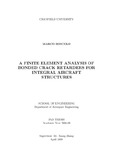JavaScript is disabled for your browser. Some features of this site may not work without it.
| dc.contributor.advisor | Zhang, Xiang | |
| dc.contributor.author | Boscolo, M. | |
| dc.date.accessioned | 2012-02-22T16:08:06Z | |
| dc.date.available | 2012-02-22T16:08:06Z | |
| dc.date.issued | 2009-04 | |
| dc.identifier.uri | http://dspace.lib.cranfield.ac.uk/handle/1826/7021 | |
| dc.description.abstract | Trends in aircraft design and manufacture are towards the reduction of manufacturing cost and structural weight while maintaining high level of safety. These reductions can be achieved by using integral structures. However, integral structures lack redundant structural members, hence fail safety is not guaranteed. Bonded selective reinforcements (straps) can obviate this problem and improve the damage tolerance capability of integral structures, although increase the design di±culties. The objective of this research is to develop an effective analysis method to predict the fatigue crack growth (FCG) life of integral structures reinforced by bonded crack retarders, determine the effectiveness of the reinforcements, and assess the important strap design parameters. The main mechanisms that influence the crack propagation have been identified, modelled, and discussed. When a crack propagates in the panel skin, bonded straps delay the fracture growth by exerting bridging forces at the crack tip. Nevertheless damage also affects the strap due to the stiffness mismatch and high stress concentration, and the strap/substrate interface is affected by a progressive delamination that advances together with the substrate crack and limits the strap bridging action. Tensile thermal residual stresses (TRS) in the cracked substrate, caused by the adhesive cure process, act to open the crack and hence increase the growth rate. Last but not least, secondary bending caused by the non-symmetric configurations induces a stress gradient along the crack front. This reduces the effectiveness of the bridging action and causes a curved crack front. An enhanced 2D FE modelling technique that takes into account of these mechanisms and their interactions has been developed and implemented in a computerprogram that interfaces the commercial code NASTRAN. This program is used to calculate the stress intensity factors and the FCG life of bonded strap reinforced integral structures. This modelling technique has been validated for a wide range of test samples in terms of TRS and their redistribution with crack propagation, disbond areas, and FCG lives. The FCG life of a large scale integral skin-stringer panel reinforced by various bonded straps has also been predicted and compared with the experiments. Numerical predictions have shown good agreement with the experimental measurements. Parametric studies have been conducted to understand the effectiveness of different strap configurations on crack growth retardation; these include different strap materials, strap dimensions and locations on the substrate. A design tool has been developed aimed at achieving optimal crack retarder design in terms of prescribed fatigue life target and minimum structural weight. In conclusion, a novel modelling tool has been developed, the effectiveness of bonded straps in retarding fatigue crack growth has been demonstrated and, following the parametric analysis, the most important parameters in the design of bonded straps have been identified. | en_UK |
| dc.language.iso | en | en_UK |
| dc.publisher | Cranfield University | en_UK |
| dc.rights | © Cranfield University 2009. All rights reserved. No part of this publication may be reproduced without the written permission of the copyright owner. | en_UK |
| dc.title | Finite element analysis of bonded crack retarders for integral aircraft structures | en_UK |
| dc.type | Thesis or dissertation | en_UK |
| dc.type.qualificationlevel | Doctoral | en_UK |
| dc.type.qualificationname | PhD | en_UK |
